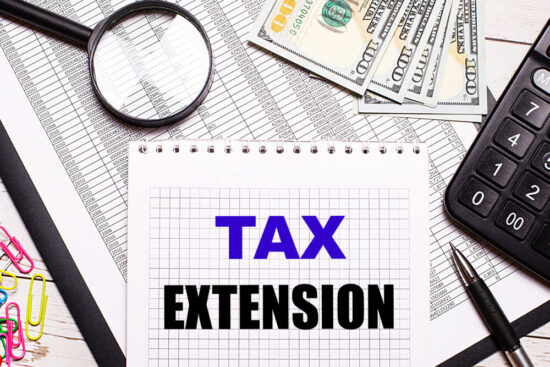
The tax filing deadline is approaching quickly. While most people are able to file by the deadline – which, for 2023, falls on April 18 – not everyone will be able to finish on time. When that happens, requesting a tax filing extension is essential. Otherwise, you may face failure-to-file penalties that can increase what you owe the IRS. Fortunately, getting a tax filing extension is simple. If you may benefit from one, here’s what you need to know.
What Is a Tax Filing Extension?
A tax filing extension essentially gives a tax filer more time to complete their annual tax return. By requesting one, you don’t have to worry about missing the initial tax deadline. Instead, you get up to six more months to file your return without being subjected to a failure-to-file penalty.
Why Would You Need a Tax Filing Extension?
The most common reason for needing a tax filing extension is not having a document you need to file an accurate return. This can occur if the required document wasn’t provided to you by the originating entity, such as not receiving a W2 from an employer or if it was lost or damaged.
Certain unanticipated events could make an extension necessary for some. For example, an illness or injury that makes filing difficult could qualify. The death of a loved one, being a victim of a natural disaster, experiencing a house fire, or being the victim of another crime can also fall into this category.
However, you don’t necessarily need a reason to request a tax filing extension. As a result, you can ask for one simply because you forgot the deadline was approaching, and now you aren’t able to finish in time.
How Do Tax Filing Extensions Work?
Tax filing extensions are pretty straightforward. After sending a request to the IRS, the extension is usually granted automatically. What matters most is getting the right form submitted before the tax deadline, as that allows you to avoid any failure-to-file penalties.
Now, it’s critical to note that a tax filing extension doesn’t give you more time to pay any taxes you owe. If the amount you’d owe the IRS based on the information in your return isn’t paid in full by the tax deadline, it will start accruing late-payment penalties and interest. These are different from the failure-to-file penalties that a tax filing extension does help you avoid. As a result, you still want to try and pay what you owe by April 18, 2023, allowing you to avoid any extra financial challenges.
If you’d be due a refund, there aren’t any late-payment penalties or interest to contend with, but that doesn’t mean you should request the extension anyway. The tax filing extension informs the IRS that you intend to file but aren’t able to make the deadline, and it doesn’t work against you to make that official.
How to Request a Tax Filing Extension
Overall, requesting a tax filing extension is simple. You’ll need to complete IRS Form 4868: Application for Automatic Extension of Time to File U.S. Individual Income Tax Return. On that form, you need to provide some personal information and estimate your tax liability. Then, you can submit it.
The IRS does allow you to file a tax filing extension request online for free. Additionally, you can typically submit one through your tax preparation software or online service. Otherwise, you can print and mail in the form using the address listed on Form 4868.
If you need to pay any estimated taxes owed, you can also submit that payment through the IRS website. Many tax preparation software applications have options for processing the payment, as well. If you’re mailing in the Form 4868, a check or money order can typically accompany the form. Just make sure you follow any instructions listed on Form 4868 to ensure it’s sent to the proper location and filled out correctly.
When Do You Need to File After Requesting an Extension?
In most years, you need to file your taxes by October 15 if you filed for an extension. But if you request a tax filing extension in 2023, you’ll have until October 17, 2023, to complete your tax filing.
The reason it’s later in the year is due to April 15, 2023, falling on a Saturday, and April 17, 2023, being a holiday in Washington, DC. That pushed back the 2023 tax deadline to Tuesday, April 18, 2023. As a result, the filing deadline after asking for an extension also shifted back.
If you miss the tax extension deadline, then you’re at risk of failure-to-file penalties. Those can add up quickly, so it’s critical to file on or before the deadline after you request the tax filing extension. That way, you can minimize what you may owe.
Is there anything else you think people need to know about a tax filing extension? Have you ever needed a tax filing extension and want to tell others about your experience requesting one? Share your thoughts in the comments below.
Read More:
- Filing Taxes Late? Here Are Some Excuses That Actually Work with the IRS
- Is It Worth Hiring Someone to Do Your Taxes?
- Effective Ways to Save Money on Business Taxes
Come back to what you love! Dollardig.com is the most reliable cash back site on the web. Just sign up, click, shop and get full cash back!
Tamila McDonald is a U.S. Army veteran with 20 years of service, including five years as a military financial advisor. After retiring from the Army, she spent eight years as an AFCPE-certified personal financial advisor for wounded warriors and their families. Now she writes about personal finance and benefits programs for numerous financial websites.
Comments